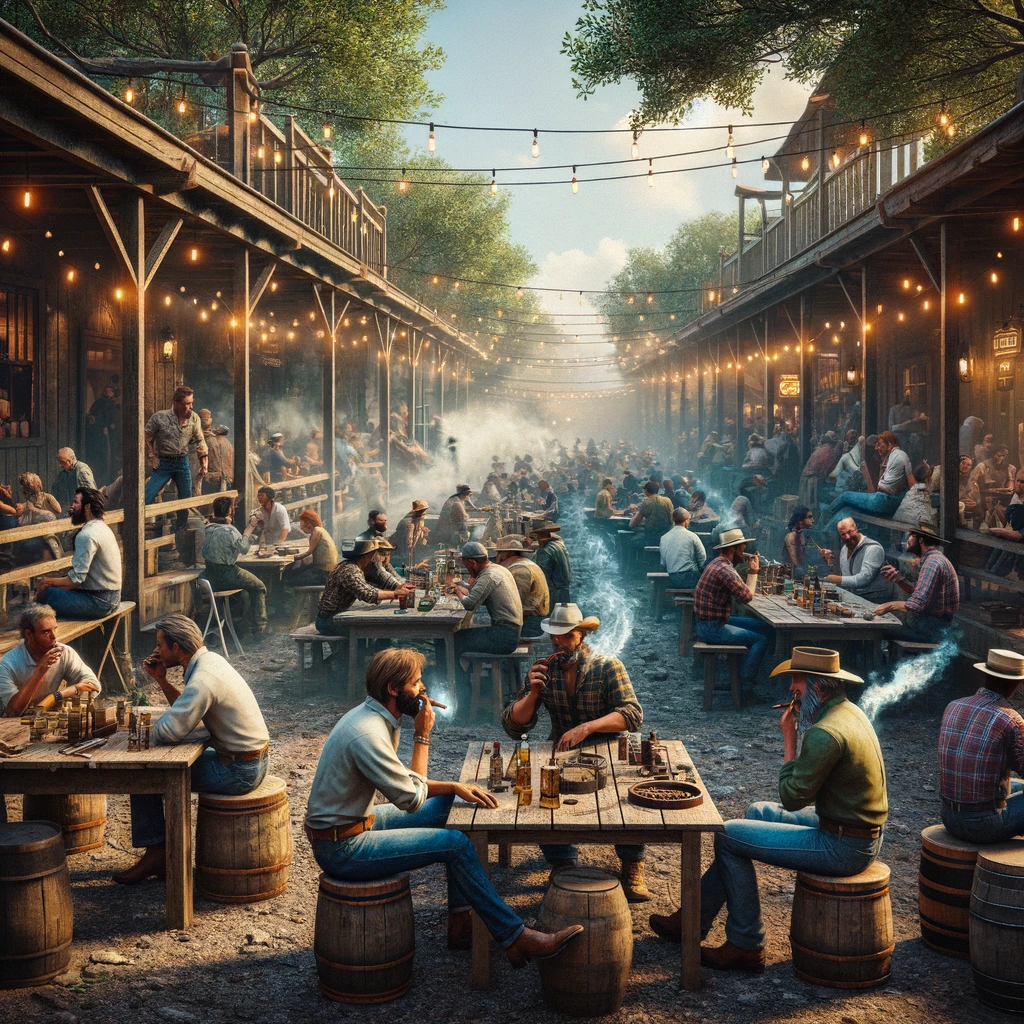Inhaling a cigar, much like any other form of tobacco consumption, has significant health implications. The act of inhaling cigar smoke introduces a myriad of harmful chemicals and toxins directly into your lungs. Unlike cigarettes, which are typically inhaled, cigars are generally meant to be savored in the mouth. Thus, inhaling them can lead to severe health issues.

The primary concern is the increased risk of developing various respiratory and cardiovascular diseases. These include chronic obstructive pulmonary disease (COPD), heart disease, and even lung cancer. The coarse smoke of a cigar contains high concentrations of carcinogenic compounds that may trigger abnormal cell growth in the lungs.
Additionally, inhaling cigar smoke can lead to nicotine addiction. Nicotine is a highly addictive substance that can cause withdrawal symptoms when not consumed regularly. It stimulates the release of dopamine in the brain, which creates a sense of pleasure and reward, making it difficult for the user to quit.
Inhalation can also lead to oral health problems. The various chemicals in cigar smoke can cause tooth decay, oral infections, gum disease, and can increase the chances of oral cancer. The lingering scent of cigar smoke may also cause bad breath.
Furthermore, inhaling cigar smoke can lead to other health issues such as throat irritation, increased risk of stroke, and premature aging of the skin. It is also associated with a higher incidence of asthma and other allergies.
Overall, while cigar smoking may be seen as a sophisticated pastime, it is essential to remember the potential health risks associated with it, especially if you choose to inhale the smoke. It is always advisable to consider these factors and make an informed decision about your health.
Retrohale
Retrohale is a term generally associated with the world of cigar and pipe smoking. It refers to the process of expelling smoke through the nasal passage instead of the mouth, a technique that is believed to enhance the smoking experience by engaging more of the smoker’s senses.
The technique of retrohaling is an integral part of the cigar or pipe smoking ritual for many enthusiasts. It is believed to allow the smoker to experience a more complete spectrum of flavors and aromas. This is due to the fact that the human tongue can only identify five basic tastes: sweet, sour, bitter, salty, and umami. However, the nose can discern a much wider range of aromas. Therefore, when smoke is expelled through the nasal passage, it allows the smoker to detect more subtle nuances in the flavor profile of the tobacco.
To successfully retrohale, one must first draw the smoke into the mouth and hold it there briefly. The next step is to open the back of the throat and push the smoke out through the nasal passage, all the while keeping the mouth closed. It may take some practice to perfect this technique and it can initially feel strange or uncomfortable. However, with time, most smokers find that it greatly enhances their overall enjoyment of the smoking experience.
It’s important to note that retrohaling is not recommended for novice smokers or those who are not accustomed to the strength of certain types of cigars or pipe tobacco. The technique can intensify the taste and sensation of the smoke, which can lead to discomfort or even a burning sensation in the nasal passage. Therefore, it is advised that beginners start with milder types of tobacco and gradually work their way up to stronger blends.
Retrohaling is a technique that has been used by tobacco enthusiasts for centuries. The practice is believed to have originated in cultures where tobacco smoking has a long history, such as in the indigenous tribes of North and South America. These early smokers recognized that the nose plays a crucial role in the perception of taste and flavor, and they developed techniques to enhance their sensory experience.
In recent years, the practice of retrohaling has gained popularity among cigar and pipe smokers around the world. This is partly due to the resurgence of interest in traditional smoking practices and the desire to experience tobacco in its purest form. Many contemporary tobacco connoisseurs consider retrohaling to be an essential part of the smoking experience, and they often share tips and techniques with each other to enhance their enjoyment.
Retrohaling is not without its critics, however. Some argue that the technique can pose risks to the smoker’s health, especially if done frequently or with strong types of tobacco. Others claim that it is unnecessary and that a good quality cigar or pipe tobacco can be fully appreciated without resorting to such methods. Despite these criticisms, the practice of retrohaling continues to have a dedicated following among tobacco enthusiasts.
In conclusion, retrohaling is a unique and interesting aspect of the cigar and pipe smoking culture. It is a technique that allows the smoker to engage more of their senses, thereby enhancing their overall experience. While it may not be suitable for everyone, for those who enjoy it, retrohaling adds an extra dimension to the ritual of smoking, making it a more satisfying and enjoyable pastime. As with all hobbies and interests, it’s important to approach it with an open mind, a willingness to experiment, and a respect for tradition.
Tips for Smoking a Cigar
The art of smoking a cigar is a timeless tradition enjoyed by many, from seasoned aficionados to novices. The process, however, can be intimidating for newcomers. Here are some tips to guide you on your journey from novice to seasoned cigar connoisseur.
Firstly, selecting the right cigar is crucial. Cigars come in various shapes, sizes, and flavors, each contributing to a unique smoking experience. When choosing a cigar, consider its strength, which ranges from mild to medium to strong. If you’re a beginner, you might want to start with a milder cigar and gradually work your way up. In terms of size, a larger cigar will last longer, while a smaller one will provide a shorter smoke.
Secondly, how you store your cigar is vital to preserving its quality. Cigars need to be stored in a humidor at a relative humidity of 68-72% and at a temperature of about 70°F. This helps maintain the moisture within the cigar, preventing it from drying out and preserving its flavor.
Cutting a cigar correctly is another important step. To do this, you’ll need a cigar cutter. The goal is to create an opening for smoking without damaging the cigar. The type of cutter you use depends on your preference, but the most commonly used are the guillotine (straight cut), punch, and V-cut. Whichever cutter you choose, make sure it’s sharp to avoid tearing the cigar wrapper.
Lighting a cigar is more than just setting it on fire. This step requires patience and precision. Use a butane lighter or a wooden match for the best results. Avoid using a regular lighter or candle as they can alter the cigar’s flavor. Slowly toast the foot (the end you light) of the cigar, rotating it to ensure an even burn. Once it’s glowing, take a puff while continuing to rotate the cigar.
Once lit, smoke your cigar slowly. Savor the flavors and aroma. A good cigar is meant to be enjoyed leisurely, not rushed. Also, unlike cigarettes, you don’t inhale the smoke from a cigar; instead, you draw it into your mouth, savor it, and then exhale.
Ashing a cigar is another aspect that differentiates it from other forms of smoking. It’s common to see cigar smokers with long ashes on their cigars. This is because the ash helps to keep the cigar burning at a lower temperature, which enhances the flavor. However, when the ash gets too long, lightly tap your cigar on the ashtray – do not forcefully stub it out.
Another tip is to rotate your cigar every now and then. This helps it to burn evenly and prevents the build-up of oils, which can affect the taste.
Lastly, knowing when to stop smoking a cigar is crucial. A good rule of thumb is to stop when about two inches are left. This is typically when the cigar starts to heat up excessively, which can result in harsh flavors.
Remember, enjoying a cigar is a personal experience, and there’s no right or wrong way to do it. What matters is that you enjoy the process and the flavors. So, don’t be swayed by the rules that others impose. Instead, find what works best for you and stick with it.
In conclusion, smoking a cigar is a unique experience that involves more than just lighting up and puffing away. It requires patience, skill, and an appreciation for the process. From selecting the right cigar, storing it correctly, cutting, lighting, smoking, and even ashing it, each step contributes to the overall experience. By following these tips, you can enjoy a cigar to its fullest and join the ranks of cigar connoisseurs worldwide.
Beginner Recommendation: LFD Suave
La Flor Dominicana (LFD) has always been regarded as a top-tier cigar company, producing some of the highest quality sticks in the industry. Although many of their offerings are created with experienced cigar enthusiasts in mind, they also offer some great options for beginners – one of which is the LFD Suave.
The LFD Suave is a perfect introductory cigar for those who are new to the world of premium cigars. This exquisite cigar is handcrafted in the Dominican Republic using a Connecticut shade wrapper and Dominican filler and binder. The Connecticut shade wrapper gives the cigar a mild to medium strength, while the Dominican filler and binder provide a rich and complex flavor profile.
One of the reasons why the LFD Suave is an excellent choice for beginners is its mildness. Many novice cigar smokers find stronger cigars a bit overwhelming. The Suave, however, is mild enough not to overpower them, yet it still offers a depth of flavor that can be appreciated even by the most seasoned aficionados.
From the moment you light up an LFD Suave, you will be greeted with a smooth, creamy smoke that is both enjoyable and easy to handle. It has a consistent burn and a draw that is neither too tight nor too loose – perfect for those who are still learning the ins and outs of cigar smoking.
The flavor profile of the LFD Suave is another reason why it is a great choice for beginners. It offers a delicate blend of earthy, nutty, and creamy flavors, with hints of spice and sweetness. The complexity of these flavors is not overwhelming, making it perfect for those who are still developing their palate.
Additionally, the LFD Suave is also an affordable option. Cigars can be quite expensive, especially the premium ones, and it can be frustrating for beginners to spend a lot of money on a cigar only to find out that they don’t like it. The Suave, however, is reasonably priced, making it a great option for those who are just starting their cigar journey.
Moreover, La Flor Dominicana is renowned for its craftsmanship, and the Suave is no exception. From the construction of the cigar to the quality of the tobacco used, every detail is meticulously taken care of. This level of craftsmanship ensures a consistent smoking experience, which is crucial for beginners who are still learning what they like and don’t like in a cigar.
In terms of pairing, the LFD Suave goes well with a variety of drinks. A cup of coffee in the morning, a glass of whiskey in the evening, or even a simple glass of water – the Suave can complement them all. This flexibility makes it a great choice for those who are still experimenting with cigar and drink pairings.

In conclusion, the LFD Suave is an excellent recommendation for beginner cigar smokers. Its mildness, flavorful profile, reasonable price, and high-quality construction make it a great introduction to the world of premium cigars. As your palate develops and you become more experienced, you may find yourself exploring stronger and more complex cigars. But even then, the LFD Suave will always be a great choice for a relaxing, enjoyable smoke.
About Cigar Country
Cigar Country is a term that refers to the regions globally recognized for their expertise in the production of high-quality cigars. These regions are primarily found in Latin America, where the tropical climate provides the ideal conditions for growing tobacco. The unique combination of sunlight, humidity, and fertile soil in these regions results in a rich, flavorful tobacco that is sought after by cigar enthusiasts around the world.
In the realm of premium cigars, two countries stand head and shoulders above the rest: Cuba and the Dominican Republic. Each of these nations boasts a rich history of tobacco cultivation and cigar production, and they are renowned for the high quality of their products.
Cuba, often referred to as the birthplace of the cigar, has a long-standing tradition of producing some of the world’s finest cigars. The country’s favorable climate and fertile soil make it the perfect place for growing tobacco. The Cuban cigar industry is famous for its meticulous cultivation and production methods, which involve carefully selecting and blending different types of tobacco to create unique and robust flavors. The most iconic Cuban cigar brand is perhaps Cohiba, initially created for Fidel Castro himself, and is now a symbol of luxury and refinement worldwide.

On the other hand, the Dominican Republic, known for its vast tobacco fields, is home to some of the most prestigious cigar manufacturers in the world. While the country’s cigar history might not be as long as Cuba’s, the Dominican Republic has quickly earned a reputation for producing cigars that rival even the best that Cuba has to offer. Brands such as Arturo Fuente and Davidoff have achieved global acclaim for their exceptional quality and craftsmanship. The country’s ability to grow a variety of tobacco types, combined with the skills of local artisans, allows for a wide range of flavors and styles, making Dominican cigars incredibly versatile and appealing to a broad spectrum of cigar enthusiasts.
Nicaragua and Honduras, despite being smaller players in the global cigar market, also deserve a mention. These countries have been making steady inroads into the premium cigar industry, with brands like Padrón and Rocky Patel gaining international recognition for their robust, flavorful cigars. The volcanic soil found in these regions imparts a unique flavor profile to the tobacco, making cigars from these countries a must-try for any cigar aficionado.
Cigar Country is not just about the production of cigars, but it is also about the culture and tradition that surround this centuries-old craft. In these countries, cigar making is seen as an art form, requiring a high level of skill and precision. It’s a process steeped in tradition, from the planting and harvesting of the tobacco to the rolling of the cigars themselves.
Visitors to these countries can immerse themselves in this rich culture by touring tobacco fields, visiting cigar factories, and even trying their hand at rolling their own cigars. These experiences offer a glimpse into the intricate process behind each cigar’s creation, making each puff a little more meaningful.
Whether you’re a seasoned cigar enthusiast or a newcomer to the world of cigars, exploring the Cigar Country is a journey worth undertaking. The opportunity to experience the passion, tradition, and craftsmanship that go into every cigar is something truly special. It’s not just about enjoying a high-quality product; it’s about appreciating the history and culture that make each cigar unique.
In conclusion, the term Cigar Country refers to the regions globally recognized for their exceptional cigar production. Cuba and the Dominican Republic are the most notable, but other countries like Nicaragua and Honduras are also making a name for themselves in the industry. Each of these countries has its unique flavor profiles and traditions, making the world of cigars a rich and diverse one to explore. So, when you light up your next cigar, remember: you’re not just smoking a product, you’re experiencing a piece of culture from the heart of Cigar Country.